
International Research Journal of Engineering and Technology (IRJET) e-ISSN: 2395-0056
Volume: 11 Issue: 12 | Dec 2024 www.irjet.net p-ISSN: 2395-0072


International Research Journal of Engineering and Technology (IRJET) e-ISSN: 2395-0056
Volume: 11 Issue: 12 | Dec 2024 www.irjet.net p-ISSN: 2395-0072
Mayuri Patil1 , Dr. N. P. Phadtare2
1PG Student, Department of Structural Engineering, PVPIT, Budhagaon.
2Prof. Dr. N. P. Phadtare, Department of Structural Engineering, PVPIT, Budhagaon, Maharashtra, India
Abstract - Box culverts are essential low-rise structures commonly utilized for channeling water beneath roadways, flyovers, and similar infrastructures. They are particularly effective in regions with low soil bearing capacity. When designed with multiple cells and a span exceeding 6 meters, these culverts are classified as minor bridges. The height of a box culvert is proportional to its span. Made predominantly from reinforced concrete, they also serve as crossings for pedestrians and vehicles while maintaining water flow beneath. The structural design incorporates factors like live loads,effectivewidth,andearthpressurecoefficients,adhering
to relevant Indian Roads Congress (IRC) standards.
Key Words: BoxCulvert,Design,IRCCode.
Aboxculvertisastructuralcomponentdesignedto allowwatertopassunderinfrastructuresuchasroadsand railways. Constructed primarily from reinforced concrete, theseculvertsfeatureabox-likeshapeandcomeinsquareor rectangular cross-sections. They play a critical role in managing drainage by directing water from streams, channels, or sewer systems while ensuring minimal disruptiontotheoverlyinginfrastructure.
Box culverts are particularly useful in areas with low soil bearing capacity, where conventional drainage solutions may fail. They are also utilized as small bridges, especiallywhentheirspansexceed6meters.Duringdesign andconstruction,severalloadfactorsaretakenintoaccount, including dead loads, live loads, moving loads, and earth pressures. Thetop slab primarilybears theseloads, while thesidewallsresistlateralsoilforces.
These culverts are highly efficient, versatile, and durable.Theyareespeciallybeneficialforspansofupto4 metersandheightstypicallylessthan3meters,makingthem ideal for areas with limited headroom. Their structural robustness and adaptability make them a cornerstone in moderncivilengineering.
The design of box culverts is guided by detailed calculationsandanalysis,conformingtocodesspecifiedby the IRC. Parameters such as live load dispersion, effective width,andearthpressurecoefficientsarecriticaltoensuring bothfunctionalityandsafety.
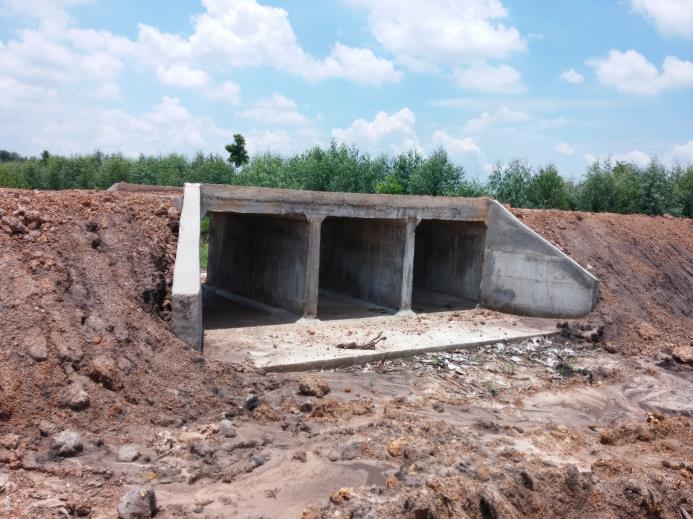
Thefollowingarethedifferenttypesofculverts:
Apipeculvertisformedbyplacingapipeinanexcavated trenchtodirectwaterflow.Itisoneofthemostwidelyused drainage solutions due to its cost-effectiveness and simplicity in installation. Pipe culverts are available in various shapes, such as circular, elliptical, and pipe arch, with the choice of shape depending on specific site conditionsandconstraints.
PipeculvertsmustadheretoISstandards,specificallyNP3 or NP4 categories. A minimum cushion of 600 mm is requiredbetweenthetopofthepipeandtheroadsurface. For fills up to 4 meters, first-class bedding made of compactedgranularmaterialissuitable,whereasforfillsup to 8 meters, concrete cradle bedding can be utilized. For smallerstructures,RCCpipeculvertswithonetosixrowsof RCC pipes may be used, depending on the discharge requirements.Theseareoftenmoreeconomicalcomparedto slabculverts.

International Research Journal of Engineering and Technology (IRJET) e-ISSN: 2395-0056
Volume: 11 Issue: 12 | Dec 2024 www.irjet.net p-ISSN: 2395-0072
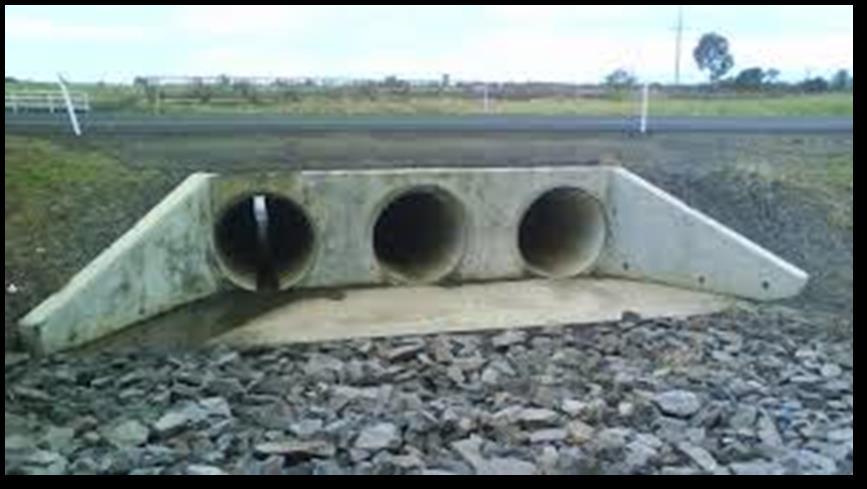
Boxculvertsareprecastconcretestructureswidelyusedin drainagesystemstochannelwatereffectively.Constructed with two horizontal and two vertical slabs joined monolithically, they are well-suited for carrying streams with limited flow beneath roads or railway bridges with elevatedembankments.
Box culverts are cost-effective due to their rigidity and monolithic structure. They do not require separate foundations, as the bottom slab serves as a raft slab that restsdirectlyontheground.Single-celledboxculvertsare designed to handle smaller water discharges, whereas multicelledboxculvertsareusedforlargerdischarges.
This design is among the most commonly used types of culverts. The concrete bottom allows smooth water flow throughthestructure.Boxculvertsaretypicallyconstructed usingreinforcedconcrete(RCC).Incaseswherewaterneeds to change direction or when significant water flow is expected,compositeconstructionmaybeemployedtomeet specificrequirements.
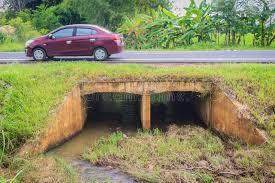
Pipearchculvertsareidealforlocationsrequiringalarge waterwayopening,offeringbetterhydraulicefficiencyand supportingaquaticlifebyenhancingwaterflowconditions. These culverts provide low clearance and have an aestheticallypleasingdesign.Theyareespeciallybeneficial in areas with limited headroom and perform effectively during low-flow conditions. Key features of pipe arch culvertsinclude:
Suitabilityforsiteswithrestrictedheadroom.
Enhancedhydraulicperformanceatlowwaterflow.
Avisuallyappealinganduniqueshape.
Lightweightconstructionforeaseofhandling.
Simpleandquickinstallationprocess.
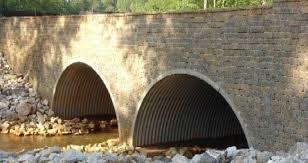
RCC solid slab culverts consist of a single horizontal reinforcedconcreteslabsupportedbyabutmentsorpiers. Theseculvertsdonotincludesidewalls,makingthemmore suitableforapplicationsinvolvinglighterloadsandshorter spans, particularly in areas with strong soils and stable geologicalconditions.
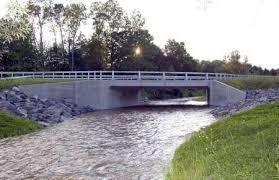

International Research Journal of Engineering and Technology (IRJET) e-ISSN: 2395-0056
Volume: 11 Issue: 12 | Dec 2024 www.irjet.net p-ISSN: 2395-0072
Roshan Patel, Sagar Jamle-(2019)-
Thisstudyprovidesadetailedmanualdesignofboxculverts, analyzingparameterssuchasearthpressure,cushiondepth, brakingforces,impactloads,liveloads,loaddispersionfrom trackedandwheeledvehicles,andeffectivewidths.Italso discussesIRCprovisionsandtheirjustifications.
Neha Kolate, Molly Mathew, Snehal Mali-(2014)-
This paper focuses on design factors such as live load dispersionangles,earthpressureeffects,andcushiondepth ontopslabs.Structuraldeformationsundervariousloading scenarios,withorwithoutcushioning,arealsoexplored.
Akash Mishra, Dr.Umesh Pendharkar-(2023)-
Thisresearchexaminesthebehaviorof3-cellboxculverts across12modelswithdifferentspan-to-heightratios(1.5, 1.75, and 2) and skew angles (0°, 17°, 34°, and 51°). The study evaluates load resistance and identifies optimal modelsforvaryingconditions.
Sachin Honwad, Sameer Chitnis-(2022)-
Thestudyinvestigatestheimpactofvaryingskewangles(0° to70°)onthebehaviorof3-cellboxculvertsusingSTAAD Pro. The analysisfocuseson the effects ofdeadloads,live loads,liveloadsurcharges,andearthpressuresonslaband wallperformance.
A. D. Patil, A. A. Galatage-(2016)-
This report examines the performance of reinforced concrete box culverts under cushion and no-cushion scenarios.Ithighlightstheeffectsofloadingcombinations, bending moments, and IRC code considerations for safe structuraldesigns.
Pragya D. Harinkhede and Prof. Varsha R. Harne (2021)-
Thisstudyfocusesontheanalysisanddesignofa30-meter MinorMulti-cellBox-typeBridgewithvaryingconfigurations ofprecastsections.Theinvestigationaccountsforvarious loads,includingDeadLoad,LiveLoad,SuperimposedDead Load,EarthPressure,andvehicleloadsasoutlinedby the Indian Road Congress (IRC). These vehicle loads include Class"A"vehicles,70RBogievehicles,70RWheeledvehicles, and70RTrackedvehicles.
ThebridgeisassessedundermultipleLoadCombinations, followingtheguidelinesfortheLimitStateofCollapseand theLimitStateofServiceability,toidentifycriticalsections for Bending Moments and Shear Forces. The primary objectiveistoperformanalysisanddesignofboxsectionsin accordancewithIRCstandards,specificallyIRC6-2017and IRC112-2011.
Sandeep Gaikwad, Tanmay Ghumde-(2021)-
InthispaperstudyaboutthedifferentclassesofIRCloadings andtheireffectonwithoutandwithcushioningconditions imposedonculvert.Thepressurecasesarethencheckedfor bothwithcushioningandwithoutcushioningloadingcases. The structure designing includes the considerations of pressure cases ( empty, Full, surcharge load) and factors suchasImpactload,Brakingforce,Dispersalofloadthrough fill,Effectivewidth,Coefficientsofearthpressure,Liveload etc.Thestructuralelementsaredesignedtowithstandthe maximumbendingmomentsandshearforcesrespectively. Inthepresentstudy,thispaperprovidesfulldiscussionon theprovisionsinthecodes,considerationsandjustifications ofalltheaboveaspectsofdesign.
1. Tostudyhydrologicalparametersessentialforbox culvertdesign.
2. TomodelandanalyzeboxculvertsusingSTAADPro underdifferentloadscenarios.
3. Toevaluatethestructuralperformanceofculverts withandwithoutcushionloadsforvaryingaspect ratios.
4. To design reinforced concrete components considering loads such as live loads, dead loads, earthpressurecoefficients,andeffectivewidth.
5. Todetermineloadcombinationsthatcausecritical stresses,ensuringasafedesign
1. Conductadetailedhydrologicalanalysis.
2. CreateandanalyzeculvertmodelsusingSTAADPro software.
3. Definematerialpropertiesanddimensionsforslabs andwalls.
4. Usespringsupportsunderthebaseslab.
5. Applyloadconditions,includingliveloads,effective widths,andearthpressurecoefficients.
6. Assess axial forces, shear forces, and bending momentsforslabsandwalls.
7. Calculate and evaluate critical stresses, moments, andforcesfordesignoptimization.
The findings indicate that the coefficient of earth pressure has minimal influence on box culvert designs withoutcushioning.

International Research Journal of Engineering and Technology (IRJET) e-ISSN: 2395-0056
Volume: 11 Issue: 12 | Dec 2024 www.irjet.net p-ISSN: 2395-0072
Culverts without cushions require less steel reinforcement and experience lower design moments and shear stresses compared to cushioned counterparts. Furthermore,increasingskewanglesamplifieslongitudinal, transverse,andtorsional momentsaswell asshearforces acrossallstructuralcomponents
[1]NehaKolate,MollyMathewandSnehalMali,―Analysis and design of RCC box culvert‖, International journal of scientific & engineering research, volume 5, issue 12, december-2014
[2]DalgobindMahto&AnjaniKumar,-AReviewonBridge ConstructionTechnology:Thispaperdescribesthedetails aboutthebridgeconstructiontechnology.
[3]Y.VinodKumarandDr. ChavaSrinivas -“Analysisand design of box culverts by using computational methods”, International Journal of Engineering & Science Research., Vol.5,ISSN.2277-2685
[4]SandeepKumarAhirwar,Mohd.AfaqueKhan,Abhishek Kumar “Review on Analysis and Behavior Investigation of Box Girder Bridges” International Research Journal of EngineeringandTechnology(IRJET),Volume3Issue4,Apr2016ISSN2395–0056
[5]A.D.Patil,A.A.Galatage,-"Analysisofboxculvertunder cushionloading",Internationaladvancedresearchjournalin science engineering &technology, ISSN no.(o)2393-8021, ISSNno.(p)2394-1588,Vol.03,Issue-03,p.p.163-166.
[6]LandeAbhijeetChandrakantandPatilVidyaMalgonda,Finiteelementanalysisofboxculvert,InternationalJournal ofAdvancedTechnologyinEngineeringandScience,Volume No.02,IssueNo.06,June2014,ISSN(online):2348–7550.
[7] M.G. Kalyanshetti and S. A. Gosavi, ―Analysis of box culvert-costoptimizationfordifferentaspectratiosofcell‖, International journal of research in engineering and technology,volume:03,issue:04,apr-2014.
[8] Ajay R. Polra, Pro. J.P Chandresha, Dr. K.B Parikh, - "A reviewpaperonanalysisandcostcomparisonofboxculvert for different aspect of cell" International journal of engineeringtrends&technology,ISSNno.2231-5381,Vol.44, Issue-03,p.p112-115.
[9]Sujatashreedharandr.shreedhar,―Designcoefficients forsingleandtwocellboxculvert,Internationaljournalof civilandstructuralengineering,volume3,no3,2013
[10] B. N. Sinha and R. P. Sharma, ―RCC Box Culvert –Methodology and Designs including computer method, Journal of the Indian Roads Congress, October-December 2009
[11] Ramamurtham & R.P. Sharma. “RCC Box Culvert Methodology and Designs including Computer method” Journal of the Indian Roads Congress, October December 2009,Paper555.
[[12] IRC: 6-2000, ―Standard Specifications and Code of PracticeforRoadBridges
IRC112-2011–MaterialsConcreteandPrestressingBridge
IRC21-2000–DesignConstants
SP013–GuidelinesforDesignofSmallBridgesandCulverts.